Aldosterone-sensitive repression of ENaCalpha transcription by a histone H3 lysine-79 methyltransferase
- PMID: 16236820
- PMCID: PMC3009459
- DOI: 10.1152/ajpcell.00431.2005
Aldosterone-sensitive repression of ENaCalpha transcription by a histone H3 lysine-79 methyltransferase
Abstract
Aldosterone is a major regulator of epithelial Na(+) absorption. One of its principal targets is the epithelial Na(+) channel alpha-subunit (ENaCalpha), principally expressed in the kidney collecting duct, lung, and colon. Models of aldosterone-mediated trans-activation of the ENaCalpha gene have focused primarily on interactions of liganded nuclear receptors with the ENaCalpha gene promoter. Herein, we demonstrate that the murine histone H3 lysine-79 methyltransferase, murine disruptor of telomeric silencing alternative splice variant "a" (mDot1a), is a novel component in the aldosterone signaling network controlling transcription of the ENaCalpha gene. Aldosterone downregulated mDot1a mRNA levels in murine inner medullary collecting ducts cells, which was associated with histone H3 K79 hypomethylation in bulk histones and at specific sites in the ENaCalpha 5'-flanking region, and trans-activation of ENaCalpha. Knockdown of mDot1a by RNA interference increased activity of a stably integrated ENaCalpha promoter-luciferase construct and expression of endogenous ENaCalpha mRNA. Conversely, overexpression of EGFP-tagged mDot1a resulted in hypermethylation of histone H3 K79 at the endogenous ENaCalpha promoter, repression of endogenous ENaCalpha mRNA expression, and decreased activity of the ENaCalpha promoter-luciferase construct. mDot1a-mediated histone H3 K79 hypermethylation and repression of ENaCalpha promoter activity was abolished by mDot1a mutations that eliminate its methyltransferase activity. Collectively, our data identify mDot1a as a novel aldosterone-regulated histone modification enzyme, and, through binding the ENaCalpha promoter and hypermethylating histone H3 K79 associated with the ENaCalpha promoter, a negative regulator of ENaCalpha transcription.
Figures

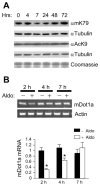
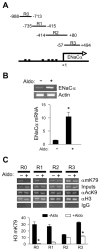
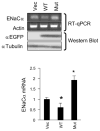

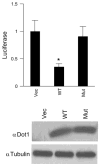
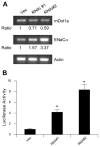

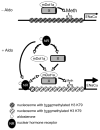
Similar articles
-
Dot1a-AF9 complex mediates histone H3 Lys-79 hypermethylation and repression of ENaCalpha in an aldosterone-sensitive manner.J Biol Chem. 2006 Jun 30;281(26):18059-68. doi: 10.1074/jbc.M601903200. Epub 2006 Apr 24. J Biol Chem. 2006. PMID: 16636056 Free PMC article.
-
Aldosterone-induced Sgk1 relieves Dot1a-Af9-mediated transcriptional repression of epithelial Na+ channel alpha.J Clin Invest. 2007 Mar;117(3):773-83. doi: 10.1172/JCI29850. J Clin Invest. 2007. PMID: 17332896 Free PMC article.
-
Sirtuin 1 functionally and physically interacts with disruptor of telomeric silencing-1 to regulate alpha-ENaC transcription in collecting duct.J Biol Chem. 2009 Jul 31;284(31):20917-26. doi: 10.1074/jbc.M109.020073. Epub 2009 Jun 2. J Biol Chem. 2009. PMID: 19491102 Free PMC article.
-
Epigenetics and the control of epithelial sodium channel expression in collecting duct.Kidney Int. 2009 Feb;75(3):260-7. doi: 10.1038/ki.2008.475. Epub 2008 Sep 24. Kidney Int. 2009. PMID: 18818687 Free PMC article. Review.
-
Epigenetics and the control of the collecting duct epithelial sodium channel.Semin Nephrol. 2013 Jul;33(4):383-91. doi: 10.1016/j.semnephrol.2013.05.010. Semin Nephrol. 2013. PMID: 24011580 Free PMC article. Review.
Cited by
-
AF17 facilitates Dot1a nuclear export and upregulates ENaC-mediated Na+ transport in renal collecting duct cells.PLoS One. 2011;6(11):e27429. doi: 10.1371/journal.pone.0027429. Epub 2011 Nov 8. PLoS One. 2011. PMID: 22087315 Free PMC article.
-
Aldosterone inhibits Dot1l expression in guinea pig cochlea.Eur J Med Res. 2023 Jan 13;28(1):26. doi: 10.1186/s40001-023-00994-y. Eur J Med Res. 2023. PMID: 36639782 Free PMC article.
-
The multifaceted mineralocorticoid receptor.Compr Physiol. 2014 Jul;4(3):965-94. doi: 10.1002/cphy.c130044. Compr Physiol. 2014. PMID: 24944027 Free PMC article. Review.
-
The upstreams and downstreams of H3K79 methylation by DOT1L.Chromosoma. 2016 Sep;125(4):593-605. doi: 10.1007/s00412-015-0570-5. Epub 2016 Jan 4. Chromosoma. 2016. PMID: 26728620 Review.
-
A comprehensive investigation of PRMT5 in the prognosis and ion channel features of lung cancer.Front Oncol. 2024 Nov 29;14:1478672. doi: 10.3389/fonc.2024.1478672. eCollection 2024. Front Oncol. 2024. PMID: 39678513 Free PMC article.
References
-
- Asher C, Wald H, Rossier BC, Garty H. Aldosterone-induced increase in the abundance of Na+ channel subunits. Am J Physiol Cell Physiol. 1996;271:C605–C611. - PubMed
-
- Boyd C, Naray-Fejes-Toth A. Gene regulation of ENaC subunits by serum- and glucocorticoid-inducible kinase-1. Am J Physiol Renal Physiol. 2005;288:F505–F512. - PubMed
-
- Cheung P, Tanner KG, Cheung WL, Sassone-Corsi P, Denu JM, Allis CD. Synergistic coupling of histone H3 phosphorylation and acetylation in response to epidermal growth factor stimulation. Mol Cell. 2000;5:905–915. - PubMed
Publication types
MeSH terms
Substances
Grants and funding
LinkOut - more resources
Full Text Sources

